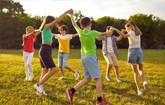HOUSTON, July 13 /PRNewswire-USNewswire/ -- NASA has selected nine experiments, designed by students at seven schools, for astronauts to perform on the International Space Station this summer. NASA selected the proposals from among 132 received for the new Kids in Micro-g! Program.
(Logo: http://photos.prnewswire.com/prnh/20081007/38461LOGO)
(Logo: http://www.newscom.com/cgi-bin/prnh/20081007/38461LOGO)
This is the pilot year for the program, a student experiment design challenge geared toward grades five through eight. Its purpose is to give students a hands-on opportunity to design experiments or simple demonstrations for testing both in the classroom and in the station's microgravity environment. The winners were chosen by a team of representatives from NASA's 10 field centers.
"What a wonderful experience for these kids to have their experiments carried out in space and by astronauts," said Mark Severance, International Space Station National Laboratory Education projects manager at NASA's Johnson Space Center in Houston. "This gives students the chance to see what happens differently, other than in the classroom, when their experiment is performed in an environment that is not on Earth."
The schools chosen to participate are:
National Winner and NASA Glenn Research Center Regional Winner
- Brownell Middle, Grosse Point Farms, Mich.
National Runner-up and NASA Kennedy Space Center Regional Winner
- Vaughan Elementary, Powder Springs, Ga.
NASA Ames Research Center Regional Winner
- Hamlin School, San Francisco
NASA Goddard Space Flight Center Regional Winners (tie)
- East Hartford-Glastonbury Magnet, East Hartford, Conn.
- Carl Sandburg Middle, Old Bridge, N.J.
NASA Kennedy Space Center Regional Winner
- Windy Ridge Elementary, Orlando, Fla.
NASA Langley Research Center Regional Winner
- Virginia Academy, Ashburn, Va.
The experiments will study the effect of weightlessness on various subjects such as humans and liquids and other materials, as well as what the environment reveals about the laws of physics. The experiments are expected to have observably different results in microgravity than when performed in the classroom.
The apparatus for the experiments was constructed using the same materials as a tool kit previously provided to astronauts on the space station. The materials in the tool kit are commonly found in the classroom and used for science demonstrations. The proposed experiments or demonstrations are required to take no more than 30 minutes to set up, run and take down.
This fall, the program will ask for proposals for 2011. To see a list of this year's selected Kids in Micro-g! experiments, visit:
http://www.nasa.gov/pdf/452456main_Kids_In_Micro_g_Final_Results.pdf
For more information about NASA educational programs, visit:
For more information about the International Space Station, visit:
SOURCE NASA
WANT YOUR COMPANY'S NEWS FEATURED ON PRNEWSWIRE.COM?
Newsrooms &
Influencers
Digital Media
Outlets
Journalists
Opted In






Share this article